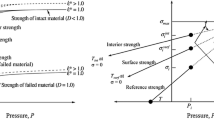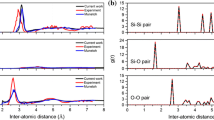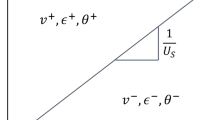Abstract
A non-equilibrium molecular dynamics method is employed to study the mechanical response of soda-lime glass (a material commonly used in transparent armor applications) when subjected to the loading conditions associated with the generation and propagation of planar shock waves. Specific attention is given to the identification and characterization of various (inelastic-deformation and energy-dissipation) molecular-level phenomena and processes taking place at, or in the vicinity of, the shock front. The results obtained revealed that the shock loading causes a 2-4% (shock strength-dependent) density increase. In addition, an increase in the average coordination number of the silicon atoms is observed along with the creation of smaller Si-O rings. These processes are associated with substantial energy absorption and dissipation and are believed to greatly influence the blast/ballistic impact mitigation potential of soda-lime glass. The present work was also aimed at the determination of the shock Hugoniot (i.e., a set of axial stress vs. density/specific-volume vs. internal energy vs. particle velocity vs. temperature) material states obtained in soda-lime glass after the passage of a shock wave of a given strength (as quantified by the shock speed). The availability of a shock Hugoniot is critical for construction of a high deformation-rate, large-strain, high pressure material model which can be used within a continuum-level computational analysis to capture the response of a soda-lime glass based laminated transparent armor structure (e.g., a military vehicle windshield, door window, etc.) to blast/ballistic impact loading.








Similar content being viewed by others
References
E. Strassburger, P. Patel, W. McCauley, and D.W. Templeton, Visualization of Wave Propagation and Impact Damage in a Polycrystalline Transparent Ceramic-AlON, Proceedings of the 22nd International Symposium on Ballistics, November 2005, Vancouver, Canada
AMPTIAC Quarterly, Army Materials Research: Transforming Land Combat Through New Technologies, AMPTIAC Quart., 2004, 8(4), p 2–5
M. Grujicic, B. Pandurangan, N. Coutris, B.A. Cheeseman, C. Fountzoulas, P. Patel, and E. Strassburger, A Ballistic Material Model for Starphire®, A Soda-lime Transparent Armor Glass, Mater. Sci. Eng. A, 2008, 492(1), p 397–411
M. Grujicic, B. Pandurangan, W.C. Bell, N. Coutris, B.A. Cheeseman, C. Fountzoulas, and P. Patel, An Improved Mechanical Material Model for Ballistic Soda-Lime Glass, J. Mater. Eng. Perform., 2009, 18(8), p 1012–1028
M. Grujicic, B. Pandurangan, N. Coutris, B.A. Cheeseman, C. Fountzoulas, and P. Patel, A Simple Ballistic Material Model for Soda-Lime Glass, Int. J. Impact Eng., 2009, 36, p 386–401
M. Grujicic, W.C. Bell, P.S. Glomski, B. Pandurangan, B.A. Cheeseman, C. Fountzoulas, P. Patel, D.W. Templeton, and K.D. Bishnoi, Multi-length Scale Modeling of High-pressure Induced Phase Transformations in Soda-lime Glass, J. Mater. Eng. Perform., 2010, 20(7), p 1144–1156
L.V. Woodcock, C.A. Angell, and P. Cheeseman, Molecular Dynamics Studies of the Vitreous State: Simple Ionic Systems and Silica, J. Chem. Phys., 1976, 65, p 1565–1577
R.G.D. Valle and E. Venuti, High-Pressure Densification of Silica Glass: A Molecular-dynamics Simulation, Phys. Rev. B, 1996, 54(6), p 3809–3816
K. Trachenko and M.T. Dove, Densification of Silica Glass Under Pressure, J. Phys.: Condens. Matter, 2002, 14, p 7449–7459
Y. Liang, C.R. Miranda, and S. Scandolo, Mechanical Strength and Coordinate Defects in Compressed Silica Glass: Molecular Dynamics Simulations, Phys. Rev. B, 2007, 75, p 024205
B. Nghiem, PhD thesis, University of Paris 6, France 1998
C. Denoual and F. Hild, Dynamic Fragmentation of Brittle Solids: A Multi-scale Model, Eur. J. Mech. Solids A, 2002, 21, p 105–120
M. Yazdchi, S. Valliappan, and W. Zhang, A Continuum Model for Dynamic Damage Evolution of Anisotropic Brittle Materials, Int. J. Numer. Methods Eng., 1996, 39, p 1555–1583
F. Hild, C. Denoual, P. Forquin, and X. Brajer, On the Probabilistic and Deterministic Transition Involved in a Fragmentation Process of Brittle Materials, Comput. Struct., 2003, 81, p 1241–1253
T.J. Holmquist, D.W. Templeton, and K.D. Bishnoi, Constitutive Modeling of Aluminum Nitride for Large Strain High-strain Rate, and High-pressure Applications, Int. J. Impact Eng., 2001, 25, p 211–231
G.T. Camacho and M. Ortiz, Computational Modeling of Impact Damage in Brittle Materials, Int. J. Solids Struct., 1996, 33, p 20–22, 2899–2938
B.L. Holian and G.K. Straub, Molecular Dynamics of Shock Waves in Three-Dimensional Solids: Transition from Nonsteady to Steady Waves in Perfect Crystals and Implications for the Rankine-Hugoniot Conditions, Phys. Rev. Lett., 1979, 43, p 1598
G.K. Straub, S.K. Schiferl, and D.C. Wallace, Thermodynamic Properties of Fluid Sodium from Molecular Dynamics, Phys. Rev. B, 1983, 28, p 312–316
V. Y. Klimenko and A. N. Dremin, in Detonatsiya, Chernogolovka, O. N. Breusov et al., Eds., AkademiiNauk, Moscow, 1978, p 79
B.L. Holian, W.G. Hoover, B. Moran, and G.K. Straub, Shock-Wave Structure Via Non-equilibrium Molecular Dynamics and Navier-Stokes Continuum Mechanics, Phys. Rev. A, 1980, 22, p 2498
W.D. Kingery, H.K. Bowen, and D.R. Uhlmann, Introduction to Ceramics, 2nd ed., John Wiley & Sons, New York, 1976, p 91–124
H. Sun, COMPASS: An ab Initio Force-Field Optimized for Condensed-Phase Applications Overview with Details on Alkane and Benzene Compounds, J. Phys. Chem. B, 1998, 102, p 7338–7364
H. Sun, P. Ren, and J.R. Fried, The COMPASS force field: parameterization and validation for phosphazenes, Comput. Theoret. Polym. Sci., 1998, 8(1/2), p 229–246
http://www.accelrys.com/mstudio/msmodeling/amorphouscell.html
M. Grujicic, Y.P. Sun, and K.L. Koudela, The Effect of Covalent Functionalization of Carbon Nanotube Reinforcements on the Atomic-level Mechanical Properties of Poly-Vinyl-Ester-Epoxy, Appl. Surf. Sci., 2007, 253, p 3009
D.N. Theodorou and U.W. Suter, Atomistic Modeling of Mechanical Properties of Polymeric Glasses, Macromolecules, 1986, 19, p 139–154
A.V. Amirkhizi, J. Isaacs, J. McGee, and S. Namet-Nasser, An Experimentally-Based Viscoelastic Constitutive Model for Polyurea, Including Pressure and Temperature Effects, Philos. Mag., 2006, 86(36), p 5847–5866
M. Grujicic, W.C. Bell, B. Pandurangan, and T. He, Blast-Wave Impact Mitigation of Polyurea When Used as a Helmet Suspension-Pad Material, Mater. Des., 2010, 31(9), p 4050–4065
M. Grujicic, W. C. Bell, B. Pandurangan and P. S. Glomski, Fluid/Structure Interaction Computational Investigation of the Blast-wave Mitigation Efficiency of the Advanced Combat Helmet, J. Mater. Eng. Perform., in press, 2010
C.S. Alexander, L.C. Chhabildas, W.D. Reinhart, and D.W. Templeton, Changes to the Shock Response of Fused Quartz Due to Glass Modification, Int. J. Impact Eng., 2008, 35, p 1376–1385
Acknowledgments
The material presented in this paper is based on work supported by the U.S. Army/Clemson University Cooperative Agreements W911NF-04-2-0024 and W911NF-06-2-0042 and by an ARC-TARDEC research contract.
Author information
Authors and Affiliations
Corresponding author
Rights and permissions
About this article
Cite this article
Grujicic, M., Bell, W.C., Pandurangan, B. et al. Molecular-Level Simulations of Shock Generation and Propagation in Soda-Lime Glass. J. of Materi Eng and Perform 21, 1580–1590 (2012). https://doi.org/10.1007/s11665-011-0064-4
Received:
Published:
Issue Date:
DOI: https://doi.org/10.1007/s11665-011-0064-4




